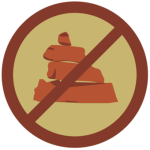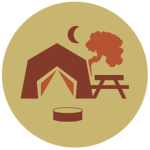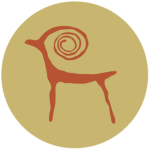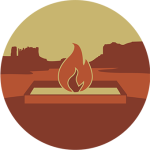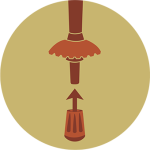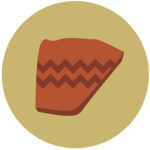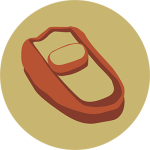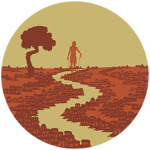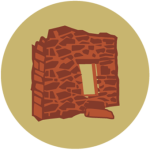
Visit With Respect

As visitors to the greater Bears Ears region, it is our responsibility to respect its natural and cultural sites both out of respect to the region’s Tribes and Pueblos, and for all visitors who come next. Over the past ten years, heightened attention and interest in the area has rapidly increased visitation, causing concern that the natural and cultural resources of Bears Ears are at great risk of being “loved to death.”
In response to the increase in visitation, we developed the Visit with Respect (VWR) campaign to encourage responsible visitation and to curb the degradation of the region's unique resources.
The VWR campaign promotes 20 key tips to help visitors enhance their experience and ensure future visitors can share in the same experience. The campaign uses icons, specific to each VWR principle, so that the messages are quickly digestible—no reading needed—and easy to remember.
These icons and their messaging are directed specifically towards the appropriate visitation of the vulnerable cultural sites that are held sacred to so many of the region’s Tribes and Pueblos, and make this landscape so unique.
Watch Visit With Respect Videos
Bears Ears Partnership has also developed a Visit with Respect Ambassador program, which trains volunteers to educate visitors out on the landscape. These Ambassadors are friendly faces, who truly make a big difference by reaching visitors in the very places we are trying to protect.
If you are interested in joining our partnership and expanding the use of Visit with Respect, please
Visit with Respect © 2018 by Bears Ears Partnership (formerly Friends of Cedar Mesa) is licensed under CC BY-NC-ND 4.0
Avoid Building Cairns
Building cairns can impact sensitive sites and are a form of vandalism to the natural world. You might not realize it, but some stacked stones may be ancestral shrines. Leave placement of trail directional signs and leveling of cairns to land managers.
Camp & Eat Away from Archaeology
Ancestral sites and structures are where Tribes and Pueblos believe their ancestors' spirits still reside. Camping, fires, and food can damage cultural sites and spoil the view for other visitors. Remember to pack out all your waste, including food scraps and poop.
Dogs & Archaeology Don’t Mix
To prevent erosion and degradation, dogs are not allowed in or near archeological sites. Always check beforehand if dogs are permitted in an area or region. Remember that many of these sites are culturally significant, so please make sure to leash pets, keep them away from cultural sites, and don’t let them dig.
Don’t Touch Rock Imagery or Make Your Own
Natural oils on your hands can destroy delicate rock imagery. Vandalism of petroglyphs and pictographs erases stories of early Indigenous peoples and destroys the experience for future visitors.
Enjoy Cultural Sites Without Ropes
This protects delicate ancestral rock imagery and structures from damage caused by falling rocks and looting. The use of climbing gear, like ropes, to access cultural sites is illegal.
Guide Children Through Sites
Sacred cultural sites are not playgrounds. Teach children to respect these places so they can share them with future generations and become better stewards of the land. Keep a close eye on them so they don’t get hurt or accidentally damage cultural belongings.
Historic Artifacts Aren’t Trash
Leave historic artifacts like rusted cans right where they are. They help interpret the past and show who has been there before.
Pay Your Fees
It may not seem like much, but your small fee helps support important monitoring, enforcement, and amenities like toilets.
Stay On Designated Roads
Use existing roads that are approved for use by land managers. Driving off-road can damage fragile archaeology and ecosystems.
Use a Fire Pan
Remember to check when and where fires are allowed. Ground fires leave scars on the landscape and a mess for the next visitor. Bring a fire pan or, at the very least, use existing fire rings. Wait until your ashes are cool to the touch and pack them out.
Use Rubber-Tipped Poles
A rubber tip prevents your hiking pole from scratching and scarring subtle rock images on the ground.
View Sites From A Distance
Many Indigenous peoples consider this landscape sacred, and numerous Tribal Elders ask visitors to view sites from a distance. This small act honors Tribal beliefs and protects cultural resources from the destructive effects of visitation, like erosion.
GPS Reveals Too Much
GPS points often lead uneducated visitors to sensitive sites. When posting online about your trip, remove all references to location.
Leave Cultural Belongings Where They Are
Cultural belongings such as pottery pieces, flakes and stone tools, corn cobs, and textiles left by early Indigenous peoples are still sacred to Tribes and Pueblos. Ancestral items and historic artifacts help researchers learn about the past. It's illegal to remove such items from public lands.
Leave Fossils & Bones Undisturbed
Leave fossils, human and non-human bones, tracks, and other paleontological remains where you find them so future visitors and scientists can learn from them.
Pack Out Your Poop
Human and pet waste threatens fragile ecosystems and drinking water for hikers and wildlife alike. Poop near cultural sites is disrespectful to the Tribes and Pueblos that revere this sacred cultural landscape. When facilities are not available, please pack out your waste.
Refrain From Grinding Ancestral Slicks
Grinding slicks and carved grooves were created by early Indigenous peoples. Respect the ancestors who left them by refraining from touching or using altered surfaces that you may encounter on the landscape.
Remember That Ancestral Landscapes Are Sacred
Tribes and Pueblos consider ancestral landscapes a place for ceremony and a place where the ancestors’ spirits still reside. The soil, sky, animals, plants, cultural and ancestral sites are all interconnected and hold spiritual significance to Tribal nations.
Stay on Established Trails
Stay on existing trails and routes to protect the living biocrust. Once stepped on, this fragile crust takes years to regrow.
Steer Clear of Ancestral Structures
Structures are spiritually alive and still hold cultural significance to Tribal peoples. When recreating, visitors should refrain from leaning on walls, no matter how solid they look and avoid touching, standing on, or climbing in structures as they can be easily damaged.


